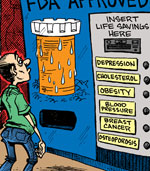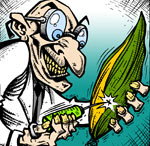Vitamin K2 Benefits
| Share on Facebook | Share on Twitter | Share on Google+ |
A little-used supplement called vitamin K2 offers enormous benefits for both cardiovascular and bone health. And a specific kind of vitamin K2 known as MK-7 outshines all the other formulations of vitamin K in helping people grow stronger bones by removing calcium for plaques in the linings of arteries. Knowing how to choose the right vitamin K supplement, however, begins with knowing vitamin K by the numbers used to describe it.
Vitamin K by the Numbers
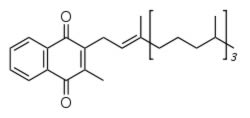
Vitamin K consists of a complex of chemicals variously named vitamin K1, vitamin K2, and vitamin K3. Actually, there are five numbered kinds of vitamin K, not just three, and some of the subtypes have up to 13 chemical variations. What is the difference? And why should you care?
Different kinds of vitamin K play different roles in health protection. The first recognized role of vitamin K was in regulating blood clotting factors. Back in the heyday of vitamin discovery, a Danish chemist named Henrik Dam noticed that chickens (thousands of vitamin research studies of the time involved chickens) placed on low-fat diets developed leaky blood vessels.
Further investigation revealed that the low-fat diets were deficient in a substance Dr. Dam called the "Koagulation Factor," Koagulation being the German word for coagulation. (Dam published his findings in a German medical journal.) This compound came to be known as vitamin K. Nowadays we would call the substances he discovered vitamin K1 and vitamin K2.
Vitamin K1, also known as phylloquinone, is found in plant foods. Natural sources of K1 include broccoli, iceberg lettuce, kale, collard greens, watercress, and spinach, as well as canola, soybean, and sunflower oil. Vitamin K2, also known as menaquinone, is found animal-derived foods and soy. Natural sources of K2 include butter, some kinds of cheese, fermented soy products, especially a product called natto, and chicken livers.
Nutritional science also recognizes vitamin K3, vitamin K4, and vitamin K5, although they are manufactured, not natural. Vitamin K3 is a synthetic chemical known as menadione. It's used in enormous quantities in the manufacturing of pet foods. Vitamin K4, menadiol acetate, is another synthetic chemical used as an injected medication to treat diseases that cause excessive bleeding. And vitamin K5, or 4-amino-2-methyl-1-napthol, is a synthetic chemical used as a fungicide.
Vitamin K1 and vitamin K2 have similar functions in the human body. However, it is a lot easier for the body to absorb vitamin K2 from animal-sourced foods and soy foods like natto than it is for the body to absorb vitamin K1 from plant foods.
A serving of spinach, for example, might contain enough vitamin K for a whole day's needs, but the vitamin K is so tightly bound in the tough fibers around the chloroplasts (where the leaf keeps chlorophyll), that only about 5% of the vitamin K1 in the spinach actually reaches the bloodstream. It is easier for the intestines to receive vitamin K1 when the plant foods containing it are combined with fat, but this only brings up the level of absorption to about 13%.
On the other hand, the human body has relatively little difficulty absorbing vitamin K2 from animal foods and fermented soy products. Adding to the confusion surrounding vitamin K nomenclature, vitamin K2 actually has two different forms.
One of these forms, menaquinone-4, also known as MK-4, is found in meat, eggs, and dairy products. The other, menaquinone-7, or MK-7 is made by the bacteria that ferment natto, the bacteria that ferment cheese (although most of the vitamin K in cheese is MK-4), and by friendly bacteria that live in the human colon. (There are actually 13 different menaquinone forms of vitamin K, but these two are the most important.) Even if you don't get vitamin K from food, you can still get small amounts of MK-7 from the bacteria that live inside you.
What is the importance of all this nomenclature? The important thing to remember is what kinds of vitamin K actually work for you if you take them. Here are the essentials:
- Both vitamin K1 and vitamin K2 "work" inside the human body.
- Vitamin K1 is in plant foods, but it is hard for the body to absorb it.
- Vitamin K2 is easier for the body to absorb, because it is usually found in fatty foods.
- The kind of vitamin K2 called MK-7, however, can be absorbed even the lining of the intestines is damaged by drugs or inflammatory disease. It doesn't have to be eaten with fatty food to enter the bloodstream.
The most useful form of vitamin K in supplements is the kind of vitamin K2 known as MK-7. It's made by bacteria, and it's effective for vegetarians. It can be absorbed by the body even on days when you've used over-the-counter pain killer than ordinarily interfere with vitamin K absorption. And it can be absorbed by the intestines even if you are on a low-fat diet or your digestive tract cannot process fat efficiently.
What Does Vitamin K Do In the Body?
The most important task of vitamin K in the human body is to help every cell use an amino acid called glutamic acid to make proteins. Glutamic acid is especially important in the brain, where it is used in the synthesis of proteins that ensure that neurons fire. Vitamin K is also used in making proteins that activate and deactivate certain genes and in regulating how the body uses the amino acids glutamine and proline.
The best-known task of vitamin K in the human body, however, is in helping the blood form factors that enable clotting to plug leaks. We'll discuss that in much greater detail in the next section.
Vitamin K-2 for Heart and Bones
Atherosclerosis is a process of hardening of the arteries that occurs when calcium infiltrates the mass of cholesterol and white blood cells stuck in the lining of the artery wall. Osteoporosis is the process of weakening of bone that occurs when bone-building cells called osteoblasts fail to replace calcium and other minerals that keep bone strong. Vitamin K2, it turns out, is important both in stopping unwanted calcification in the lining of arteries and for encouraging essential calcification in bone.
In the bones, vitamins K1 and K2 play a role in the formation of a substance called matrix Gla protein, or MGP. Vitamin K2 also is needed for a process called carboxylation that activates MGP so it can facilitate the rebuilding of bone to keep it strong after fractures and death of bone cells.
In the arteries, MGP turns out prevent calcification. People who don't have enough vitamin K to make MGP not only can suffer weak bones, they can suffer hardened arteries. Vitamin K is essential for the formation and activation both of MGP and another hormone, called osteocalcin, that ensure that calcium goes where it is needed in the body and not where it can cause harm.
A lot of what medical science knows about the role of vitamin K in cardiovascular health comes from the Rotterdam Study. In 1990, Dutch scientists began tracking the health of 10,994 men and women over the age of 55 who lived in Ommord, a suburb of Rotterdam. They tracked these study volunteers until their premature deaths, in a few cases, or for 10 years, ending the study in the year 2000. The researchers collected extensive dietary data from 4,807 of the participants.
One of the relationships the scientists studied was the connection between cholesterol and vitamin K. They found four beneficial connections between vitamin K and cholesterol.
- Participants in the Rotterdam Study who had the highest consumption of vitamin K1 and vitamin K2 had the highest HDL (good) cholesterol.
- Participants in the Rotterdam Study who had the highest levels of K2 had the lowest total cholesterol.
- Participants in the study who were in the top third of vitamin K2 consumption had 41% fewer heart attacks (both fatal and non-fatal).
- The fewest deaths from cardiovascular disease and the fewest deaths from all causes occurred in the study participants who consumed the most vitamin K.
Low vitamin K consumption was associated with higher rates of death from cardiovascular disease. High vitamin K consumption was associated with the lowest rates of hardening of the arteries (atherosclerosis).
Vitamin K2 and Bone Health
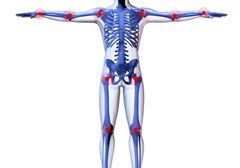
One of the many differences between people and, for instance, giant jellyfish, is that people have hundreds of bones that give the human body its interior framework. These hundreds of bones also protect the inner organs. They make it possible for different parts of the body to move in different directions. They transmit vibrations that actually play an important role in hearing and touch sensation.
To be precise, there are 206 bones from the crown of the head to the tips of the toes. If you took a course in anatomy, you probably learned all 206 bones by studying a skeleton, and it's easy to get into the mindset that maybe somehow the bones are not really living tissue. But the truth is that the bones are living tissue, and unlike a skeleton, they aren't really hard tissue.
Bones are made up of tissue that is almost as metabolically active as the heart, the liver, and the brain. The outer layer of the bone protects a spongy interior known as the trabecula. Holes in the trabecula can accumulate and eventually some kind of physical stress will fracture or break the bone.
To accommodate growth during childhood and adolescence, and to repair damage to bone at any point during life, the bones are constantly remodeling themselves. This process liberates calcium to be used by the rest of the body, especially by the kidneys as the regulate the body's pH (acidity vs. alkalinity). Remodeling also keeps bones strong and flexible, quite unlike the dry and brittle bones you might see in a skeleton. Every cell in bone is replaced about every seven years.
During the first 20 years of life, the growth process, accomplished by a group of cells known as osteoblasts, predominates over the recycling process, accomplished by a group of cells known as osteoclasts. After we mature, for about 10 years during our 20's, there is a nearly perfect balance of bone creation and bone destruction. After the age of 30, the balance between osteoblasts and osteoclasts slowly shifts in favor of the osteoclasts that break down bone.
Bone destruction begins to exceed bone creation by a factor of about 1% per year. In medical terms, the processes of bone synthesis and bone resorption become "uncoupled," and bones become progressively less resilient and more brittle throughout the rest of life. The less metabolically active the bones are, the more likely they are to have more resorption than synthesis, to break down more bone than they replace.
The reason older bones that are metabolically "slower" bones tend to break is that making bone is not the only thing a bone has to do. Bones are a kind of nursery for baby blood cells, and they also have to make proteins like collagen, the same protein that is also found in connective tissues and the skin. They store toxic heavy metals in their matrix so the rest of the body is not poisoned. They store essential fatty acids, and they also play roles in the ways the body stores fat and responds to insulin.
Stimulating the bones is not necessarily a good thing. Sometimes they manage to build new bone at normal rates, but excesses of stress hormones (cortisol), thyroid hormone, parathyroid hormone, or hormones released by cancerous tumors accelerate bone breakdown about 10 times more.
Or bad nutrition simply deprives the bones both of the calcium and magnesium they need to restore their mineral status and the vitamin K needed to make mineral absorption possible. Tiny fractures in bone accumulate so that shoulders slump and hip bones break, causing some of the predictable-and preventable-health catastrophes of aging.
Who Is At Greatest Risk for Osteoporosis?
The standard medical information is that certain groups are at greater risk for osteoporosis than others.
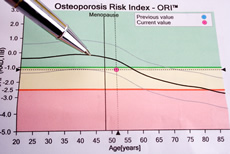
- Women are more likely to develop osteoporosis than men.
- Older people (50 years old and up) are more likely to develop osteoporosis than younger people.
- People of Asian and European descent are more likely to develop osteoporosis than people of Hispanic or African descent.
- People whose parents or siblings develop osteoporosis are more likely to develop osteoporosis themselves.
- Men who have low levels of testosterone and women who have low levels of estrogen are more likely to develop osteoporosis than men who have normal or high levels of testosterone and women who have normal or high levels of estrogen.
- People who have "small bones" are more likely to develop osteoporosis than people who have "big bones."
- People who weigh less than 127 pounds (57 kilos) are more likely to develop osteoporosis than people who weigh more than 127 pounds (57 kilos).
- Women who have their first period after the age of 16 are more likely to develop osteoporosis than women who have their first period before the age of 16.
- Women who enter menopause before the age of 45 (without having had hysterectomy) and more likely to develop osteoporosis than women who enter menopause after the age of 45.
There is not a lot to be done about those factors except to recognize them and take all possible precautions. But there are other predisposing factors for osteoporosis over which we and our physicians have some degree of control.
- Smokers are more likely to develop osteoporosis than non-smokers.
- Heavy drinkers and people who never drink alcohol are more likely to develop osteoporosis than people who take 2 or 3 alcoholic drinks each week.
- People who never exercise are more likely to develop osteoporosis than people who exercise regularly.
- People who only do aerobic exercise are more likely to develop osteoporosis than people who do resistance training (weight lifting and similar activities).
- People who eat the highest amounts of meat and dairy products are more likely to develop osteoporosis than people who eat moderate amounts of meat and dairy products, due to the use of calcium by the kidneys to prevent acidification of the bloodstream.
Vitamin K Supplements for Bone Health
More than for any other condition, vitamin K supports recovery from osteoporosis. More than any other kind of vitamin K, the form of vitamin K2 known as MK-7, the kind of vitamin K made by bacterial fermentation, supports bone health.
Japanese researchers first found MK-7 in the slimy, stringy soybean snack called natto. If you happen to spend a "night out with the guys" watching baseball in one of hundreds of thousands of tiny sports bars all over Japan, chances are you will be offered a beer and a bowl of natto.
The first time I was offered natto, when I was out with the president of a nutritional supplements company in Tokyo, I thought that the soybean snack had to be some kind of joke. The tiny fermented soybeans are coated with a stringy, gelatinous substance that looks something like mucus. I even fumbled through my Japanese dictionary to ask if I were being served freshly fertilized sea urchin eggs. (I wasn't. That happens to be a breakfast food.)
The "slime" is where the MK-7 is found. Even with my limited command of the Japanese language, I quickly learned that I was being offered a treat, not a trick, and once you get past the texture of the dish, natto is actually tasty. (Or maybe this was after I had a second beer. I really don't remember.)
The Ministry of Health in Japan has sponsored clinical investigations that confirm that MK-7 prevents and treats osteoporosis. In Japan, you can't get a bowl of natto under your health insurance plan, but you certainly can get a bottle of MK-7. This soybean-derived nutritional supplement has entered the leagues of supplements that are almost medicinal, also including SAM-e.
How do doctors know MK-7 promotes bone health?
Scientists at the Research Center for Genomic Medicine affiliated with Saitama Medical University in Saitama, Japan have found that this form of vitamin K2 activates a growth activation factor in the osteoblasts that build up bone.
Along with bee pollen and, interestingly, wasabi (the real thing, not the fake wasabi powder you get in many Western sushi bars), natto in the diet helps prevent osteoporosis in laboratory animals. And Japanese researchers have found that providing natto fortified with vitamin K2 (in the form of MK-7), in a product called kinnotsubu hogenki reduces rates of osteoporosis in women.
It's important to note that some clinical trials haven't found positive results. A study published in the journal Osteoporosis International in October 2010 failed to find a benefit in just eating natto for preventing osteoporosis in women who had gone through early menopause.
And researchers at Kobe International University have found that vitamin K1, the kind of the vitamin found in green vegetables, is essential for preventing fractures, too. But taking products that combine vitamin K1 with vitamin K2 in the form of MK-7 seem to promote bone health.
Is Vitamin K2 Enough for Bone Health?
A lot of the writing about vitamin K2 is product-focused, on the lines of "Here is why you should buy my vitamin K product." The picture painted by research, however, is that vitamin K2 is just part of the nutritional foundation for bone health. It is necessary to get enough calcium, magnesium, phosphorous, and vitamin D, and it turns out that vitamins K1 and K2 need isoflavones, like those in soy, and beta-cryptoxanthin, a phytonutrient found in yellow vegetables, to be maximally protective.
I'm not going to tell you that you really need to go out and buy seven supplements instead of one. I'm just going to tell you that vitamin K for bone health works best when you get its six factors, and here is one way to do it:
- The body can only absorb about 550 mg of calcium in any 4-hour period. Larger amounts of calcium only cause constipation. Don't take any calcium supplement that contains more than 550 mg of calcium per dose, and only take 1 dose at a time. Up to 1,200 mg a day may be helpful, but it's best to eat a variety of foods that contain calcium. Not just dairy products but also fish and green vegetables are rich in calcium.
- Magnesium is also provided by green vegetables. If you don't eat vegetables, take at least 400 mg of supplemental magnesium every day. Up to 1,800 mg a day may be helpful, but increase your dosage slowly (adding 200 mg a day) to make sure you don't trigger stomach upset. Better yet, eat four or five servings of green vegetables every day.
- Phosphorous is provided by protein foods. Almost no one in the Western world suffers a phosphorous deficiency.
- You really can get your vitamin D from sunshine, assuming you can get 20 minutes of strong sun on unprotected skin every day during the summer and 1-2 hours of strong sun on unprotected skin every day during the winter. If you can't, take at least 1,000 IU of supplemental vitamin D every day. Like calcium and magnesium, vitamin D is a very inexpensive supplement.
- Soy isoflavones are absorbed in small amounts. If you have ever lived or visited in Japan, you may have noticed that the servings of tofu and miso are tiny, just enough to provide about 15 grams (1/2 oz) of minimally processed soy every day. Your body cannot absorb the isoflavones from any more soy than just that tiny amount, although it can absorb the vitamin K2 from up to about 60 grams (2 oz) of natto.
- Cryptoxanthin is found in apples, papayas, egg yolks, butter, and beef blood. Of all the cofactors of vitamin K2, cryptoxanthin is probably the most important to take as a supplement (unless you eat a lot of beef blood or eggs). If you are also concerned about eye health, just take one of the supplements providing both lutein and beta-cryptoxanthin to reduce risk of macular degeneration.
There are several excellent vitamin K products for support of bone health on the market. The one with which I am the most familiar is Bone-Protec by Xtend-Life. It provides vitamin K2, calcium, magnesium, vitamin D, and mangosteen extract for the beta-cryptoxanthin source. It also contains bone-protective silicon, boron, and lycopene. When you consider that it's got 8 supplements in one serving, it's a bargain, and like all Xtend-Life products, there is a limited-time guarantee.
Sources:
American Academy of Pediatrics Committee on Fetus and Newborn (July 2003). "Controversies concerning vitamin K and the newborn. American Academy of Pediatrics Committee on Fetus and Newborn". Pediatrics 112 (1 Pt 1): 191-2. PMID 12837888.
Ansell J, Hirsh J, Poller L, Bussey H, Jacobson A, Hylek E (2004). "The pharmacology and management of the vitamin K antagonists: the Seventh ACCP Conference on Antithrombotic and Thrombolytic Therapy". Chest 126 (3 Suppl): 204S-233S. doi:10.1378/chest.126.3_suppl.204S.PMID 15383473. (summary)
Asakura, H; Myou S, Ontachi Y, Mizutani T, Kato M, Saito M, Morishita E, Yamazaki M, Nakao S (2001). "Vitamin K administration to elderly patients with osteoporosis induces no hemostatic activation, even in those with suspected vitamin K deficiency". Osteoporosis International 12 (12): 996-1000. PMID 11846334.
Bentley R, Meganathan R (September 1982). "Biosynthesis of vitamin K (menaquinone) in bacteria". Microbiol. Rev. 46 (3): 241-80. PMC 281544. PMID 6127606.
Beulens JW, Bots ML, Atsma F, Bartelink ML, Prokop M, Geleijnse JM, Witteman JC, Grobbee DE, van der Schouw YT. High dietary menaquinone intake is associated with reduced coronary calcification. Atherosclerosis. 2009 Apr;203(2):489-93.
Booth SL, Tucker K, Chen H, et al. (2000). "Dietary vitamin K intakes are associated with hip fracture but not with bone mineral density in elderly men and women". Am J Clin Nutr 71: 1201-1208.
Buczek O, Bulaj G, Olivera BM (December 2005). "Conotoxins and the posttranslational modification of secreted gene products". Cell. Mol. Life Sci. 62 (24): 3067-79. doi:10.1007/s00018-005-5283-0.PMID 16314929.
Cheung, AM; Weber, P; Willett, WC; Rockett, H; Booth, SL; Colditz, GA; Hu, H; Vieth, R et al. (2008)."Vitamin K supplementation in postmenopausal women with osteopenia (ECKO trial): a randomized controlled trial". PLoS Med. 5 (10): e196. doi:10.1371/journal.pmed.0050196. PMC 2566998.PMID 18922041.
Cockayne, S; Adamson J, Lanham-New S, Shearer MJ, Gilbody S, Torgerson DJ (2006). "Vitamin K and the Prevention of Fractures: Systematic Review and Meta-analysis of Randomized Controlled Trials". Archives of Internal Medicine 166 (12): 1256-1261. PMID 16801507.
Conly, J; Stein K (1994). "Reduction of vitamin K2 concentrations in human liver associated with the use of broad spectrum antimicrobials". Clinical and investigative medicine. Medecine clinique et experimentale 17 (6): 531-539. PMID 7895417.
Coutu DL, Wu JH, Monette A, Rivard GE, Blostein MD, Galipeau J (2008). "Periostin, a member of a novel family of vitamin K-dependent proteins, is expressed by mesenchymal stromal cells". J. Biol. Chem. 283 (26): 17991-18001. doi:10.1074/jbc.M708029200. PMID 18450759.
Crowther MA, Douketis JD, Schnurr T, et al. (2002). "Oral vitamin K lowers the international normalized ratio more rapidly than subcutaneous vitamin K in the treatment of warfarin-associated coagulopathy. A randomized, controlled trial" (PDF). Ann. Intern. Med. 137 (4): 251-4.PMID 12186515.
Dam, H. (1935). "The Antihaemorrhagic Vitamin of the Chick.: Occurrence And Chemical Nature".Nature 135 (3417): 652-653. doi:10.1038/135652b0.
Dam, Henrik (December 12, 2024). The discovery of vitamin K, its biological functions and therapeutical application. Nobel Prize lecture
Davidson, RT; Foley AL, Engelke JA, Suttie JW (1998). "Conversion of Dietary Phylloquinone to Tissue Menaquinone-4 in Rats is Not Dependent on Gut Bacteria". Journal of Nutrition 128 (2): 220-223. PMID 9446847.
Davidson, RT; Foley AL, Engelke JA, Suttie JW (1998). "Conversion of Dietary Phylloquinone to Tissue Menaquinone-4 in Rats is Not Dependent on Gut Bacteria1". Journal of Nutrition 128 (2): 220-223. PMID 9446847.
Dr. Susan E. Brown, PhD. "Key vitamins for bone health - vitamins K1 and K2". womentowomen.com. Retrieved 11 August 2010.
Drenckhahn, D. & Kugler, P (2003), "Knochengewebe". In Benninhoff & D. Drenhahn, Anatomie Band 1:147. Munich, Germany: Urban & Fisher Elder SJ, Haytowitz DB, Howe J, Peterson JW, Booth SL (January 2006). "Vitamin k contents of meat, dairy, and fast food in the U.S. Diet". J. Agric. Food Chem. 54 (2): 463-7.doi:10.1021/jf052400h. PMID 16417305.
Ferland, G; Sadowski JA, O'Brien ME (1993). "Dietary induced subclinical vitamin K deficiency in normal human subjects". Clinical and investigative medicine. Medecine clinique et experimentale 91(4): 1761-1768.
Feskanich, Diane; Weber, P; Willett, W; Rockett, H; Booth, S; Colditz, G (1999). "Vitamin K intake and hip fractures in women: a prospective study". American Journal of Clinical Nutrition 69 (1): 74.PMID 9925126.
Fieser, L. F. (1939). "Synthesis of Vitamin K1". Journal of the American Chemical Society 61: 3467-3475. doi:10.1021/ja01267a072.
Furie B, Bouchard BA, Furie BC (15 March 2024). "Vitamin K-dependent biosynthesis of gamma-carboxyglutamic acid". Blood 93 (6): 1798-808. PMID 10068650.
Geleijnse J. M. et coll. Dietary Intake of Menaquinone is Associated with a Reduced Risk of Coronary Heart Disease: The Rotterdam Study. The American Society for Nutritional Sciences J. Nutr. 134:3100-3105, November 2004.
Gerald JA, Katie JW, Asiri R W, et al. (2009). "Vitamin K promotes mineralization, osteoblast-to-osteocyte transition, and an anticatabolic phenotype by ?-carboxylation-dependent and independent mechanisms". Am J Physiol Cell Physiol 297: C1358-C1367.
Groenen-van Dooren MM et coll. "Bioavailability of phylloquinone and menaquinones after oral and colorectal administration in vitamin K-deficient rats". Biochem Pharmacol. 1995 Sep 7;50(6):797-801.
Haddock BA, Jones CW (March 1977). "Bacterial respiration". Bacteriol Rev 41 (1): 47-99.PMC 413996. PMID 140652.
Hafizi S, Dahlback B (2006). "Gas6 and protein S. Vitamin K-dependent ligands for the Axl receptor tyrosine kinase subfamily". FEBS J. 273 (23): 5231-44. doi:10.1111/j.1742-4658.2006.05529.x.PMID 17064312.
Higdon (February 2008)."Vitamin K" . Linus Pauling Institute, Oregon State University. Retrieved 2008-04-12.
Hodges, SJ; Pilkington MJ, Shearer MJ, Bitensky L, Chayen J (1990). "Age-related changes in the circulating levels of congeners of vitamin K2, menaquinone-7 and menaquinone-8". Clin Sci (Lond)78 (1): 63-66.
Ikeda; Iki, M; Morita, A; Kajita, E; Kagamimori, S; Kagawa, Y; Yoneshima, H (2006). "Intake of fermented soybeans, natto, is associated with reduced bone loss in postmenopausal women: Japanese Population-Based Osteoporosis (JPOS) Study.". The Journal of nutrition 136 (5): 1323-8.PMID 16614424.
Iketani, T; Kiriike N, B. Stein M (2003). "Effect of menatetrenone (vitamin K2) treatment on bone loss in patients with anorexia nervosa". Psychiatry Research 117 (3): 259-269. PMID 12686368.
Inoue, T; Sugiyama T, Matsubara T, Kawai S, Furukawa S (2001). "Inverse correlation between the changes of lumbar bone mineral density and serum undercarboxylated osteocalcin after vitamin K2 (menatetrenone) treatment in children treated with glucocorticoid and alfacalcidol.". Endocrine Journal 48 (1): 11-18. PMID 11403096.
Iwamoto, I; Kosha S, Noguchi S-i (1999). "A longitudinal study of the effect of vitamin K2 on bone mineral density in postmenopausal women a comparative study with vitamin D3 and estrogen-progestin therapy.". Maturitas 31 (2): 161-164. PMID 10227010.
Iwamoto, I; Kosha S, Noguchi S-i (1999). "A longitudinal study of the effect of vitamin K2 on bone mineral density in postmenopausal women a comparative study with vitamin D3 and estrogen-progestin therapy". Maturitas 31 (2): 161-164. PMID 10227010.
Iwamoto, J; Takeda T, Ichimura S (2000). "Effect of combined administration of vitamin D3 and vitamin K2 on bone mineral density of the lumbar spine in postmenopausal women with osteoporosis". Journal of Orthopaedic Science 5 (6): 546-551. PMID 11180916.
Kanai, T (1997). "Serum vitamin K level and bone mineral density in post-menopausal women".International Journal of Gynecology & Obstetrics 56: 25. doi:10.1016/S0020-7292(96)02790-7.
Katsuyama; Ideguchi, S; Fukunaga, M; Saijoh, K; Sunami, S (2002). "Usual dietary intake of fermented soybeans (Natto) is associated with bone mineral density in premenopausal women.".Journal of nutritional science and vitaminology 48 (3): 207-15. PMID 12350079.
Komai M, Shirakawa H. Vitamin K metabolism. Menaquinone-4 (MK-4) formation from ingested VK analogues and its potent relation to bone function. Clin Calcium. 2007 Nov;17(11):1663-72.Komai M, Shirakawa H. Vitamin K metabolism. Menaquinone-4 (MK-4) formation from ingested VK analogues and its potent relation to bone function. Clin Calcium. 2007 Nov;17(11):1663-72.
Kulman JD, Harris JE, Xie L, Davie EW (2007). "Proline-rich Gla protein 2 is a cell-surface vitamin K-dependent protein that binds to the transcriptional coactivator Yes-associated protein". Proc. Natl. Acad. Sci. U.S.A. 104 (21): 8767-72. doi:10.1073/pnas.0703195104. PMID 17502622.
Lian J, Stewart C, Puchacz E, Mackowiak S, Shalhoub V, Collart D, Zambetti G & Stein G (1989). "Structure of the rat osteocalcin gene and regulation of vitamin D-dependent expression". Proc Natl Acad Sci 86: 1143-1147.
MacCorquodale, D. W.; Binkley, S. B.; Thayer, S. A.; Doisy, E. A. (1939). "On the constitution of Vitamin K1". Journal of the American Chemical Society 61: 1928-1929. doi:10.1021/ja01876a510.
Magnusson S, Sottrup-Jensen L, Petersen TE, Morris HR, Dell A (August 1974). "Primary structure of the vitamin K-dependent part of prothrombin". FEBS Lett. 44 (2): 189-93. doi:10.1016/0014-5793(74)80723-4. PMID 4472513.
Mann KG (1999). "Biochemistry and physiology of blood coagulation". Thromb. Haemost. 82 (2): 165-74. PMID 10605701.
McGee, W (2024-02-01). "Vitamin K". MedlinePlus. Retrieved 2009-04-02.
McKeown NM, Jacques PF, Gundberg CM, et al (June 2002). "Dietary and nondietary determinants of vitamin K biochemical measures in men and women". J. Nutr. 132 (6): 1329-34.PMID 12042454.
Neil C Binkley, Diane C Krueger, Tisha N Kawahara, Jean A Engelke, Richard J Chappell and John W Suttie. "A high phylloquinone intake is required to achieve maximal osteocalcin {gamma}-carboxylation". American Journal of Clinical Nutrition 76 (5).
Nelsestuen GL, Zytkovicz TH, Howard JB (October 1974). "The mode of action of vitamin K. Identification of gamma-carboxyglutamic acid as a component of prothrombin". J. Biol. Chem. 249(19): 6347-50. PMID 4214105.
Nimptsch K, Rohrmann S, Kaaks R, Linseisen J. Dietary vitamin K intake in relation to cancer incidence and mortality: results from the Heidelberg cohort of the European Prospective Investigation into Cancer and Nutrition (EPIC-Heidelberg). Am J Clin Nutr. 2010 May;91(5):1348-58. Epub 2010 Mar 24.
Nimptsch K, Rohrmann S, Linseisen J (April 2008). "Dietary intake of vitamin K and risk of prostate cancer in the Heidelberg cohort of the European Prospective Investigation into Cancer and Nutrition. (EPIC-Heidelberg)". Am. J. Clin. Nutr. 87 (4): 985-92. PMID 18400723.
Nishiguchi, S; Shimoi S, Kurooka H (2001). "Randomized pilot trial of vitamin K2 for bone loss in patients with primary biliary cirrhosis". Journal of Hepatology 35 (4): 543-545. PMID 11682046.
Oldenburg J, Bevans CG, Müller CR, Watzka M (2006). "Vitamin K epoxide reductase complex subunit 1 (VKORC1): the key protein of the vitamin K cycle". Antioxid. Redox Signal. 8 (3-4): 347-53.doi:10.1089/ars.2006.8.347. PMID 16677080.
Presnell SR, Stafford DW (June 2002). "The vitamin K-dependent carboxylase". Thromb. Haemost.87 (6): 937-46. PMID 12083499.
Price PA (1988). "Role of vitamin-K-dependent proteins in bone metabolism". Annu. Rev. Nutr. 8: 565-83. doi:10.1146/annurev.nu.08.070188.003025. PMID 3060178.
Purwosunu, Y; Muharram, Rachman IA, Reksoprodjo S, Sekizawa A (2006). "Vitamin K2 treatment for postmenopausal osteoporosis in Indonesia". The journal of obstetrics and gynaecology research 32 (2): 230-234. PMID 16594930.
Ronden, JE; Drittij-Reijnders M-J, Vermeer C, Thijssen HHW (1998). "Intestinal flora is not an intermediate in the phylloquinone-menaquinone-4 conversion in the rat". Biochimica et Biophysica Acta (BBA) - General Subjects 1379 (1): 69-75. PMID 9468334.
Ronden, JE; Drittij-Reijnders M-J, Vermeer C, Thijssen HHW. (1998). "Intestinal flora is not an intermediate in the phylloquinone-menaquinone-4 conversion in the rat". Biochimica et Biophysica Acta (BBA) - General Subjects 1379 (1): 69-75. PMID 9468334.
Ronden, JE; Groenen-van Dooren MMCL, Hornstra G, Vermeer C (1997). "Modulation of arterial thrombosis tendency in rats by vitamin K and its side chains". Atherosclerosis 132 (1): 61-67.PMID 9247360.
Sano; Fujita, H; Morita, I; Uematsu, H; Murota, S (1999). "Vitamin K2 (menatetrenone) induces iNOS in bovine vascular smooth muscle cells: no relationship between nitric oxide production and gamma-carboxylation.". Journal of nutritional science and vitaminology 45 (6): 711-23. PMID 10737225.
Sasaki, N, Kusano E, Takahashi H, Ando Y, Yano K, Tsuda E, Asano Y; Kusano E, Takahashi H, Ando Y, Yano K, Tsuda E, Asano Y (2005). "Vitamin K2 inhibits glucocorticoid-induced bone loss partly by preventing the reduction of osteoprotegerin (OPG)". Journal of bone and mineral metabolism23 (1): 41-47. PMID 15616893.
Sato, Y; Honda Y, Kaji M (2002). "Amelioration of osteoporosis by menatetrenone in elderly female Parkinson's disease patients with vitamin D deficiency". Bone 31 (1): 114-118.PMID 12110423.
Sato, Y; Honda Y, Kuno H, Oizumi K (1998). "Menatetrenone ameliorates osteopenia in disuse-affected limbs of vitamin D- and K-deficient stroke patients". Bone 23 (3): 291-296. PMID 9737352.
Sato, Y; Kanoko T, Satoh K, Iwamoto J (2005). "Menatetrenone and vitamin D2 with calcium supplements prevent nonvertebral fracture in elderly women with Alzheimer's disease". Bone 36 (1): 61-68. PMID 15664003.
Sato, Y; Kanoko T, Satoh K, Iwamoto J (2005). "Menatetrenone and vitamin D2 with calcium supplements prevent nonvertebral fracture in elderly women with Alzheimer's disease". Bone 36 (1).PMID 15664003.
Saxena SP, Israels ED, Israels LG (2001). "Novel vitamin K-dependent pathways regulating cell survival.". Apoptosis 6 (1-2): 57-68. doi:10.1023/A:1009624111275. PMID 11321042.
Sell, DR; Monnier VM (1990). "End-stage renal disease and diabetes catalyze the formation of a pentose-derived crosslink from aging human collagen". Journal of Clinical Investigation 85 (2): 380-384. PMID 2298912.
Shearer MJ (January 1995). "Vitamin K". Lancet 345 (8944): 229-34. doi:10.1016/S0140-6736(95)90227-9. PMID 7823718.
Shiomi, S; Nishiguchi S, Kubo S (2002). "Vitamin K2 (menatetrenone) for bone loss in patients with cirrhosis of the liver". The American Journal of Gastroenterology 97 (4): 978-981.PMID 12003435.
Shiraki, M; Shiraki Y, Aoki C, Miura M (2000). "Vitamin K2 (Menatetrenone) Effectively Prevents Fractures and Sustains Lumbar Bone Mineral Density in Osteoporosis". Journal of Bone and Mineral Research 15 (3): 515-522. PMID 10750566.
Somekawa, Y; Chigughi M, Harada M, Ishibashi T (1999). "Use of vitamin K2 (menatetrenone) and 1,25-dihydroxyvitamin D3 in the prevention of bone loss induced by leuprolide". The Journal of clinical endocrinology and metabolism 84 (8): 2700-2704. PMID 10443663.
Spronk, HMH; Soute BAM, Schurgers LJ, Thijssen HHW, De Mey JGR, Vermeer C (2003). "Tissue-Specific Utilization of Menaquinone-4 Results in the Prevention of Arterial Calcification in Warfarin-Treated Rats". Journal of vascular research 40 (6): 531-537. PMID 14654717.
Stafford DW (August 2005). "The vitamin K cycle". J. Thromb. Haemost. 3 (8): 1873-8.doi:10.1111/j.1538-7836.2005.01419.x. PMID 16102054.
Stenflo J, Fernlund P, Egan W, Roepstorff P (July 1974). "Vitamin K dependent modifications of glutamic acid residues in prothrombin". Proc. Natl. Acad. Sci. U.S.A. 71 (7): 2730-3.doi:10.1073/pnas.71.7.2730. PMC 388542. PMID 4528109.
Suttie JW (1985). "Vitamin K-dependent carboxylase". Annu. Rev. Biochem. 54: 459-77.doi:10.1146/annurev.bi.54.070185.002331. PMID 3896125.
Suttie, JW (1995). "The importance of menaquinones in human nutrition". Annual Review of Nutrition 15: 399-417. PMID 8527227.
Terlau H, Olivera BM (January 2004). "Conus venoms: a rich source of novel ion channel-targeted peptides". Physiol. Rev. 84 (1): 41-68. doi:10.1152/physrev.00020.2003. PMID 14715910.
Thane CW, Bates CJ, Shearer MJ, et al (June 2002). "Plasma phylloquinone (vitamin K1) concentration and its relationship to intake in a national sample of British elderly people". Br. J. Nutr.87 (6): 615-22. doi:10.1079/BJNBJN2002582. PMID 12067432.
Thijssen, HHW; Drittij-Reijnders MJ (1994). "Vitamin K distribution in rat tissues: dietary phylloquinone is a source of tissue menaquinone-4". British Journal of Nutrition 72 (3): 415-425.PMID 7947656.
Tsukamoto Y, Ichise H, Kakuda H, Yamaguchi M (2000). "Intake of fermented soybean (natto) increases circulating vitamin K2 (menaquinone-7) and gamma-carboxylated osteocalcin concentration in normal individuals". J. Bone Miner. Metab. 18 (4): 216-22.doi:10.1007/s007740070023. PMID 10874601.
Ushiroyama, T; Ikeda A, Ueki M (2002). "Effect of continuous combined therapy with vitamin K2 and vitamin D3 on bone mineral density and coagulofibrinolysis function in postmenopausal women". Maturitas 41 (3): 211-221. PMID 11886767.
Vermeer, C; Braam L (2001). "Role of K vitamins in the regulation of tissue calcification". Journal of bone and mineral metabolism 19 (4): 201-206. PMID11448011 .
Warner, E. D.; Brinkhous, K. M.; Smith, H. P. (1938). Proceedings of the Society of Experimental Biology and Medicine 37: 628.
Weber, P (2001). "Vitamin K and bone health". Nutrition 17: 880-887.
Whitlon DS, Sadowski JA, Suttie JW (April 1978). "Mechanism of coumarin action: significance of vitamin K epoxide reductase inhibition". Biochemistry 17 (8): 1371-7. doi:10.1021/bi00601a003.PMID 646989.
Will, BH; Usui Y, Suttie JW (1992). "Comparative Metabolism and Requirement of Vitamin K in Chicks and Rats". Journal of Nutrition 122 (12): 2354-2360. PMID 1453219.
Yamano M, Yamanaka Y, Yasunaga K, Uchida K (September 1989). "Effect of vitamin K deficiency on urinary gamma-carboxyglutamic acid excretion in rats". Nippon Ketsueki Gakkai Zasshi 52 (6): 1078-86. PMID 2588957.
Yonemura, K; Fukasawa H, Fujigaki Y, Hishida A. (2004). "Protective effect of vitamins K2 and D3 on prednisolone-induced loss of bone mineral density in the lumbar spine". American Journal of Kidney Diseases : the Official Journal of the National Kidney Foundation 43 (1): 53-60.PMID 14712427.
Yonemura, K; Kimura M, Miyaji T, Hishida A (2000). "Short-term effect of vitamin K administration on prednisolone-induced loss of bone mineral density in patients with chronic glomerulonephritis".Calcified Tissue International 66 (2): 123-128. PMID 10652960.
-
Skin CareMen Skin Care
-
Free ResourcesFree eBooks
-
Whatever we put our attention on will grow stronger in our life.Maharishi Mahesh Yogi
-
What We RecommendIf you do an analysis of the ingredients in a bottle of
 Total Balance and compare with other products you will find that it provides exceptional value for money…even against simple mass produced products with lower bottle costs.
Total Balance and compare with other products you will find that it provides exceptional value for money…even against simple mass produced products with lower bottle costs.
-
